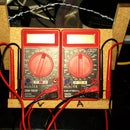Introduction: [Experimental] Mini Greenhouses
I was looking at making some mini greenhouses for some raised garden beds.
There are two common options people usually use for this.
Recycled glass cold frame
[example instructable]
Pros:
- Glass (especially multi-pane) has good thermal insulation
- Look good
- Last a long time
Cons:
- Tend to be small (only as big as the glass you find)
- Difficult to move
- Shatter if a rock lands on them
- Snow will pile up on the
Hoop greenhouse from PVC and plastic sheeting
[example instructable]
Pros:
- Lightweight
- Taller inside for taller plants
- Can be as big as you want
Cons:
- Plastic deteriorates in about 2-3 seasons
- Wind can tear it easily
- Mediocre insulation
The purpose of this experiment was to come up with a third option. Something easy and affordable that will last a long time, gather maximum sunlight, and be easy to build and move around.
P.S. This is also found on my projects blog, here:
http://theheadlesssourceman.wordpress.com/2013/05/28/experimental-mini-greenhouses/
Step 1: Plan
If you want to more easily figure out the ideal angles for your latitude you can use the attached (zipped) spreadsheet or you can simply work it out from the equation in the pic.
Even simpler still, it turns out that for 40º latitude the numbers work out to not far from 60 degrees for the front and the back. This is extremely convenient, since if you remember trigonometry class, 60 degrees is a perfect equilateral triangle! That makes this thing REALLY easy to build! Also, if I assume your latitude is probably like mine -- cold enough that you'll need a greenhouse and yet warm enough that you don't need a full-blown large, heated greenhouse -- I can say 60 degrees is probably a reasonable angle for your location as well!
Attachments
Step 2: Materials
The only problem is they want like $150 a sheet for the stuff! Again, I probably should have just caved and got the right material but I discovered something else I wanted to try. Basically, that coroplast plastic they use to make signs out of... they actually make "clear" sheets (Cor-X brand) that are, well, not clear like polycarbonate, but more like the polyethylene sheeting you would use for your hoop greenhouse.
You can see what I mean in the picture. Notice how the concrete shows through, yet not as much as it would through glass.
So I grabbed some of that and some regular white coroplast. The greenhouse book I had said that white for the back wall is better than shiny because it prevents hot-spots. You can either buy a new sheet like I did or better yet, gather up and recycle the (usually illegal) marketoid clutter you see alongside the road. For that matter you could use a sheet of anything you can scrounge, really. Maybe even rigid foam insulation with some paint to provide you more R-value on the north side? In other words, pretty much anything and paint it white.
To hold it all together I used a weather-resistant roll of the handyman's secret weapon, duct tape.
(By the way. Cost for 1 1/2 sheets of 4x8 white coroplast plus 1 sheet of clear... these mini-greenhouses work out to about $40 USD apiece.)
Step 3: Assemble
Now it's just a matter of taping the whole thing together. It looks simple, and in a way it is, but you probably need a helper because floppy sheets this big are hard to tame.
Step 4: Experiment Results
So how well do they work?
Well, these things were designed from the beginning to be "light and easy to move around".
The design was highly successful, but interestingly, that proved to be it's downfall!
As soon as the trees lost their leaves for the winter, the wind load picked up and the greenhouses went a-tumbling, and broke apart.
Growl.
I reassembled and re-enforced the corners with 2x2 boards where the sides meet the ends. I recommend this enhancement for anybody.
Also, I added 60 degree triangles to the center of the top. I'm not sure how necessary this is, and it is more difficult than strengthening the ends. May or may not be worth it. (Especially since you could shorten the length and get the same results.)
I spent the rest of the winter playing the same game, attempting to secure the greenhouses, waiting for the next storm, fixing what broke, etc.
Underneath, however, the plants (in pots) did great! In fact, even the grass underneath them stayed green all winter.
IN CONCLUSION:
I think these would work extremely well in low-wind areas. Perhaps one could even secure them to a raised garden bed. In a high-wind area, however, even tent stakes and rope do little to hold such a large "sail" against the force of the gale.
NEXT STEPS:
Having learned a few lessons, I intend to use a similar concept to create an all-in-one outdoor aquaponics module. Stay tuned for that! :)

Participated in the
Gardening Contest

Participated in the
Instructables Green Design Contest












